Fabrication of CoFe2O4 Nanowire Using a Double-Pass Porous Alumina Template with a Large Range of Pore Diameters
Abstract
1. Introduction
2. Experimental
2.1. Preparation of Double-Pass AAO Template
2.1.1. The Pretreatment of Aluminum Film
2.1.2. Two-Step Anodization
2.1.3. Removal of the Barrier Layer
2.2. Preparation of CFO Nanowires
2.3. Characterizations of AAO and CFO Nanowires
3. Results and Discussion
3.1. Using a Mixed Acid of Phosphoric Acid and Oxalic Acid as the Electrolyte
3.2. Using PMMA as Filler
3.3. Characterization of CFO Nanowires
4. Conclusions
Author Contributions
Funding
Conflicts of Interest
References
- Gudiksen, M.S.; Lauhon, L.J.; Wang, J.; Smith, D.C.; Lieber, C.M. Growth of nanowire superlattice structures for nanoscale photonics and electronics. Nature 2002, 415, 617–620. [Google Scholar] [CrossRef] [PubMed]
- Wang, Z.W.; Cai, J.Q.; Wu, Y.Z.; Wang, H.J.; Xu, X.L. Ordered silicon nanorod arrays with controllable geometry and robust hydrophobicity. Chin. Phys. B 2014, 24, 017802. [Google Scholar] [CrossRef]
- Petrov, V.M.; Bichurin, M.I.; Srinivasan, G. Electromechanical resonance in ferrite-piezoelectric nanopillars, nanowires, nanobilayers, and magnetoelectric interactions. J. Appl. Phys. 2010, 107, 073908.1–073908.6. [Google Scholar] [CrossRef]
- Zheng, H.; Han, M.G.; Deng, L.J. Fabrication of CoFe2O4 ferrite nanowire arrays in porous silicon template and their local magnetic properties. Chin. Phys. B 2016, 25, 026201. [Google Scholar] [CrossRef]
- Pervaiz, E.; Gul, I.H.; Anwar, H. Hydrothermal synthesis and characterization of CoFe2O4 nanoparticles and nanorods. J. Supercond. Novel Magn. 2013, 26, 44193. [Google Scholar] [CrossRef]
- Zhen, L.; He, K.; Xu, C.Y.; Shao, W.Z. Synthesis and characterization of single-crystalline MnFe2O4 nanorods via a surfactant-free hydrothermal route. J. Magn. Magn. Mater. 2008, 320, 2672–2675. [Google Scholar] [CrossRef]
- Zhang, D.E.; Zhang, X.J.; Ni, X.M.; Zheng, H.G.; Yang, D.D. Synthesis and characterization of NiFe2O4 magnetic nanorods via a PEG-assisted route. J. Magn. Magn. Mater. 2005, 292, 79–82. [Google Scholar] [CrossRef]
- Mehri, A.; Ebrahimi, S.A.S.; Masoudpanah, S.M. Synthesis and characterization of high aspect ratio NiFe2O4 nanowire. J. Anal. Appl. Pyrolysis. 2014, 110, 235–238. [Google Scholar] [CrossRef]
- Pirouzfar, A.; Ebrahimi, S.A.S. Optimization of sol-gel synthesis of CoFe2O4 nanowires using template assisted vacuum suction method. J. Magn. Magn. Mater. 2014, 370, 1–5. [Google Scholar] [CrossRef]
- Ebrahimi, F.; Ashrafizadeh, F.; Bakhshi, S.R. Tuning the magnetic properties of high aligned strontium ferrite nanowires formed in alumna template. J. Alloys Compd. 2016, 656, 237–244. [Google Scholar] [CrossRef]
- Hua, Z.H.; Chen, R.S.; Li, C.L.; Yang, S.G.; Lu, M.; Gu, B.X.; Du, Y.W. CoFe2O4 nanowire arrays prepared by template electrodeposition method and further oxidization. J. Alloys Compd. 2007, 427, 199–203. [Google Scholar] [CrossRef]
- Xu, Y.; Xue, D.S.; Gao, D.Q.; Fu, J.L.; Fan, X.L.; Guo, D.W.; Gao, B.; Sui, W.B. Ordered CoFe2O4 nanowire arrays with preferred crystal orientation and magnetic anisotropy. Electrochim. Acta 2009, 54, 5684–5687. [Google Scholar] [CrossRef]
- Gao, D.; Shi, Z.; Xu, Y.; Zhang, J.; Yang, G.J.; Zhang, J.L.; Wang, X.H.; Xue, D.S. Synthesis, magnetic anisotropy and optical properties of preferred oriented zinc ferrite nanowire arrays. Nanoscale Res. Lett. 2010, 5, 1289–1294. [Google Scholar] [CrossRef] [PubMed]
- Zheng, H.; Han, M.; Zheng, L.; Zheng, L.; Zheng, P.; Wu, Q.; Deng, L.J.; Qin, H.B. Preparing magnetic yttrium iron garnet nanodot arrays by ultrathin anodic alumina template on silicon substrate. Appl. Phys. Lett. 2015, 34, 064201. [Google Scholar] [CrossRef]
- Xu, Z.; Zheng, H.; Han, M. Preparation and morphology magnetic properties of yttrium iron garnet nanodot arrays on Gd3Ga5O12 substrate. Chem. Phys. Lett. 2017, 680, 90–93. [Google Scholar] [CrossRef]
- Bornemann, S.; Minar, J.; Braun, J.; Ködderitzsch, D.; Ebert, H. Ab-initio description of the magnetic shape anisotropy due to the Breit interaction. Solid State Commun. 2010, 152, 85–89. [Google Scholar] [CrossRef]
- Atchudan, R.; Perumal, S.; Yong, R.L. Highly graphitic carbon nanosheets synthesized over tailored mesoporous molecular sieves using acetylene by chemical vapor deposition method. RSC Adv. 2015, 5, 93364–93373. [Google Scholar] [CrossRef]
- Datta, A.; Sangle, A.; Hardingham, N.; Cooper, C.; Kraan, M.; Ritchie, D.; Narayan, V.; Kar-Narayan, S. Structure and Thermoelectric Properties of Bi2−xSbxTe3 Nanowires Grown in Flexible Nanoporous Polycarbonate Templates. Materials 2017, 10, 553. [Google Scholar] [CrossRef]
- Zheng, H.; Han, M.; Zheng, L.; Zheng, L.; Zheng, P.; Wu, Q.; Deng, L.J.; Qin, H.B. Porous silicon templates prepared by Cu-assisted chemical etching. Mater. Lett. 2014, 118, 146–149. [Google Scholar] [CrossRef]
- Manzano, C.V.; Bürki, G.; Pethö, L.; Michler, J.; Philippe, L. Determining the diffusion mechanism for high aspect ratio ZnO nanowires electrodeposited into anodic aluminum oxide. J. Mater. Chem. 2017, 5, 1706–1713. [Google Scholar] [CrossRef]
- Masuda, H.; Fukuda, K. Ordered metal nanohole arrays made by a two-step replication of honeycomb structures of anodic alumina. Science 1995, 268, 1466–1468. [Google Scholar] [CrossRef]
- Chahrour, K.M.; Ahmed, N.M.; Hashim, M.R.; Elfadill, N.G.; Ahmad, M.A.; Bououdina, M. Influence of wet etching time cycles on morphology features of thin porous Anodic Aluminum oxide (AAO) template for nanostructure’s synthesis. J. Phys. Chem. Solids 2015, 87, 1–8. [Google Scholar] [CrossRef]
- Belwalkar, A.; Grasing, E.; Geertruyden, W.V.; Huang, Z.; Misiolek, W.Z. Effect of processing parameters on pore structure and thickness of anodic aluminum oxide (AAO) tubular membranes. J. Membr. Sci. 2008, 319, 192–198. [Google Scholar] [CrossRef]
- Sulka, G.D.; Parkota, K.G. Temperature influence on well-ordered nanopore structures grown by anodization of aluminium in sulphuric acid. Electrochim. Acta 2007, 52, 1880–1888. [Google Scholar] [CrossRef]
- Sulka, G.D.; Parkota, K.G. Anodizing potential influence on well-ordered nanostructures formed by anodisation of aluminium in sulphuric acid. Thin Solid Films 2006, 515, 338–345. [Google Scholar] [CrossRef]
- Schneider, J.J.; Engstler, J.; Budna, K.P.; Christian, T.; Steffen, F. Freestanding, highly flexible, large area, nanoporous alumina membranes with complete through-hole pore morphology. Eur. J. Inorg. Chem. 2005, 2005, 2352–2359. [Google Scholar] [CrossRef]
- Li, Y.; Ling, Z.Y.; Wang, J.C.; Chen, S.S.; Hu, X.; He, X.H. Fabrication of porous alumina templates with a large-scale tunable interpore distance in a H2C2O4-C2H5OH-H2O solution. Chin. Sci. Bull. 2008, 53, 1608–1612. [Google Scholar] [CrossRef]
- Martín, J.; Manzano, C.V.; Martín-González, M. In-depth study of self-ordered porous alumina in the 140–400 nm pore diameter range. Microporous Mesoporous Mater. 2012, 151, 311–316. [Google Scholar] [CrossRef]
- Chen, W.; Wu, J.S.; Xia, X.H. Porous Anodic Alumina with Continuously Manipulated Pore/Cell Size. ACS Nano 2008, 2, 959–965. [Google Scholar] [CrossRef]
- Ding, G.Q.; Zheng, M.J.; Xu, W.L.; Shen, W.Z. Fabrication of controllable free-standing ultrathin porous alumina membranes. Nanotechnology 2005, 16, 1285–1289. [Google Scholar] [CrossRef]
- Su, Z.; Hähner, G.; Zhou, W. Investigation of the pore formation in anodic aluminum oxide. J. Mater. Chem. 2005, 18, 5787–5795. [Google Scholar] [CrossRef]
- Batlle, X.; Garcia, D.M.M.; Tejada, J.; Gornert, P.; Sinn, E. Magnetic study of M-type doped barium ferrite nanocrystalline powders. J. Appl. Phys. 1993, 74, 3333. [Google Scholar] [CrossRef]
- Hendriksen, P.V.; Linderoth, S.; Lindgard, P.A. Finite-size modifications of the magnetic properties of clusters. Phys. Rev. B 1993, 48, 7259–7273. [Google Scholar] [CrossRef] [PubMed]
- Linderoth, S.; Balcells, L.; Labarta, A.; Tejada, J.; Hendriksen, P.V.; Sethi, S.A. Magnetization and Mossbauer studies of ultrafine Fe-C particles. J. Magn. Magn. Mater. 1993, 124, 269–276. [Google Scholar] [CrossRef]
- Otani, O.; Miyajima, H.; Chikazumi, H.; Hirosawa, S.; Sagawa, M. Magnetization processes in Nd-Fe-B permanent magnets. J. Magn. Magn. Mater. 1986, 60, 168–170. [Google Scholar] [CrossRef]
- Chithra, M.; Anumol, C.N.; Sahu, B.; Sahoo, S.C. Exchange spring like magnetic behavior in cobalt ferrite nanoparticles. J. Magn. Magn. Mater. 2016, 401, 1–8. [Google Scholar] [CrossRef]
- Li, X.; Guo, F.; Wang, S.Y.; Wang, X.; Xu, X.L.; Gao, J.; Liu, W.F. Template-free synthesis of Nd0.1Bi0.9FeO3 nanotubes with large inner diameter and wasp-waisted hysteresis loop. Appl. Phys. Lett. 2015, 107, 062903. [Google Scholar] [CrossRef]
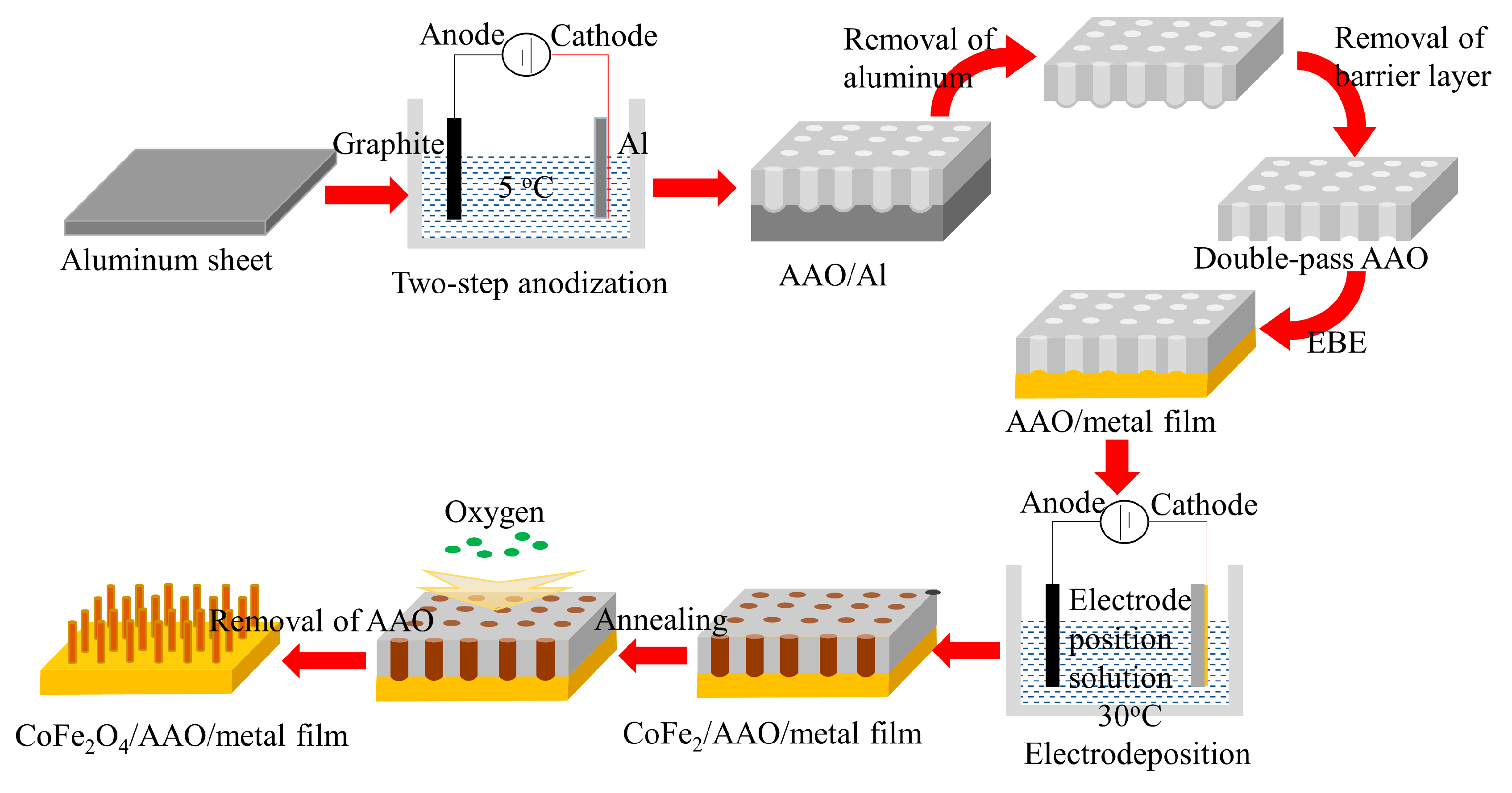


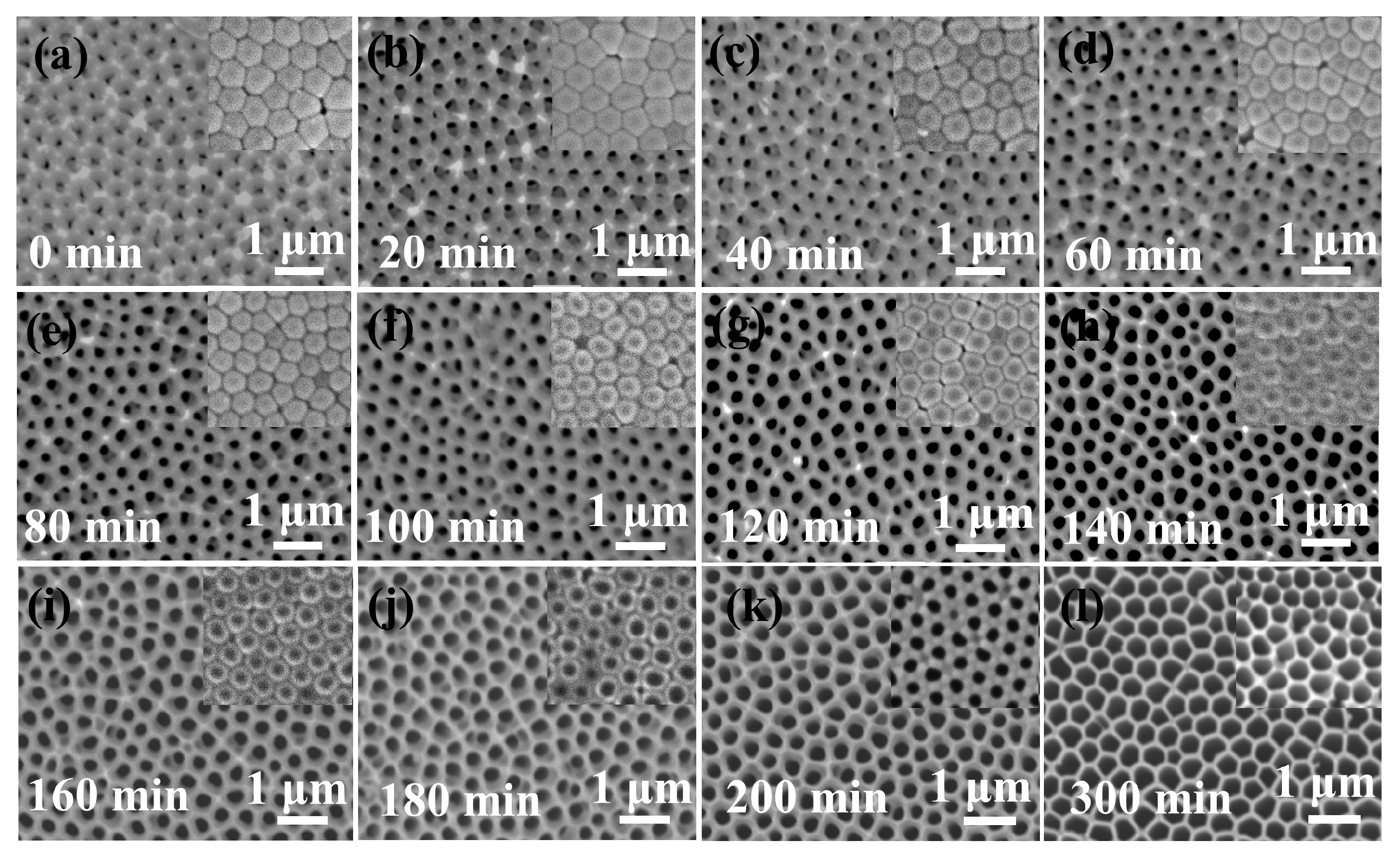
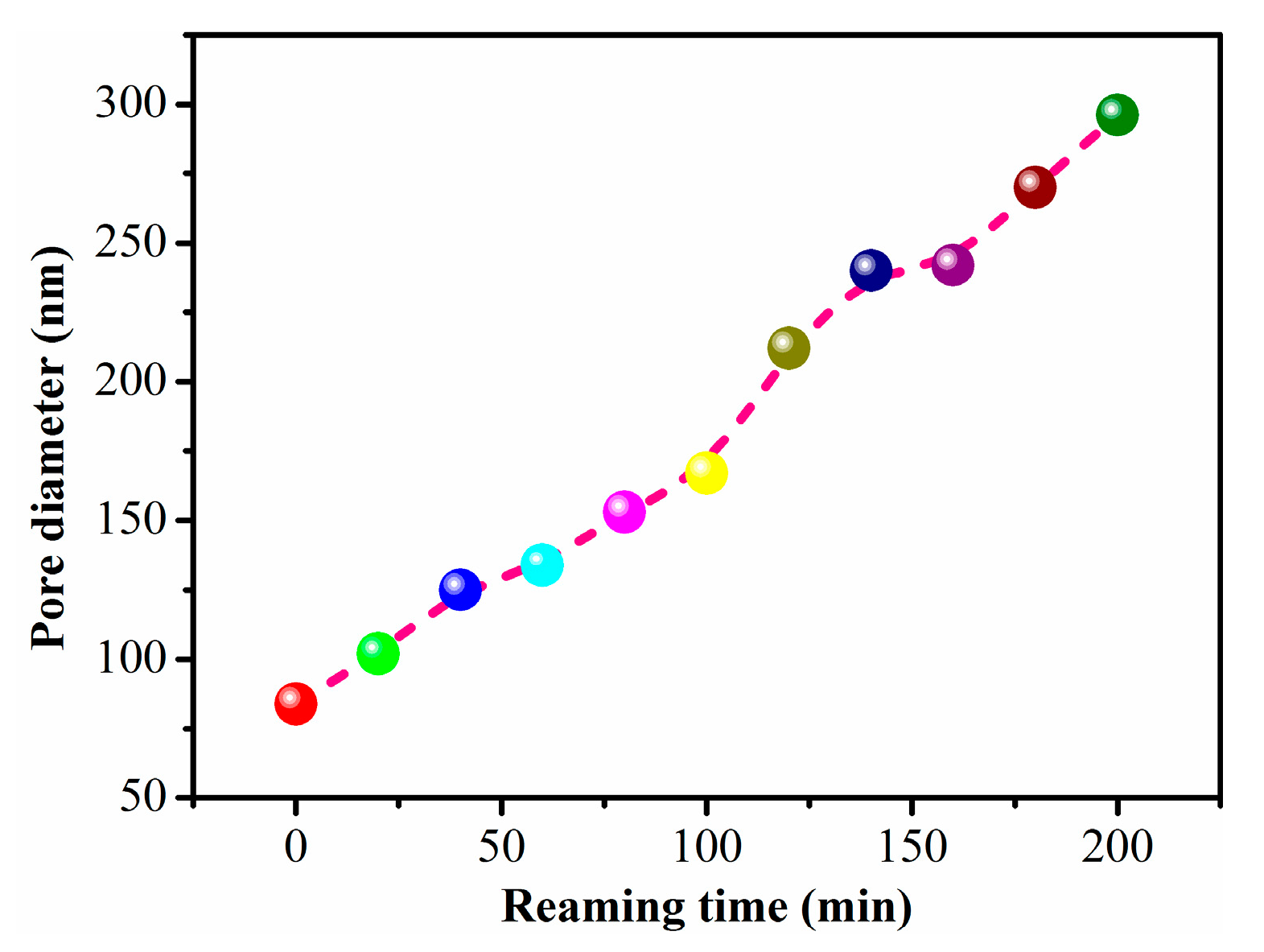

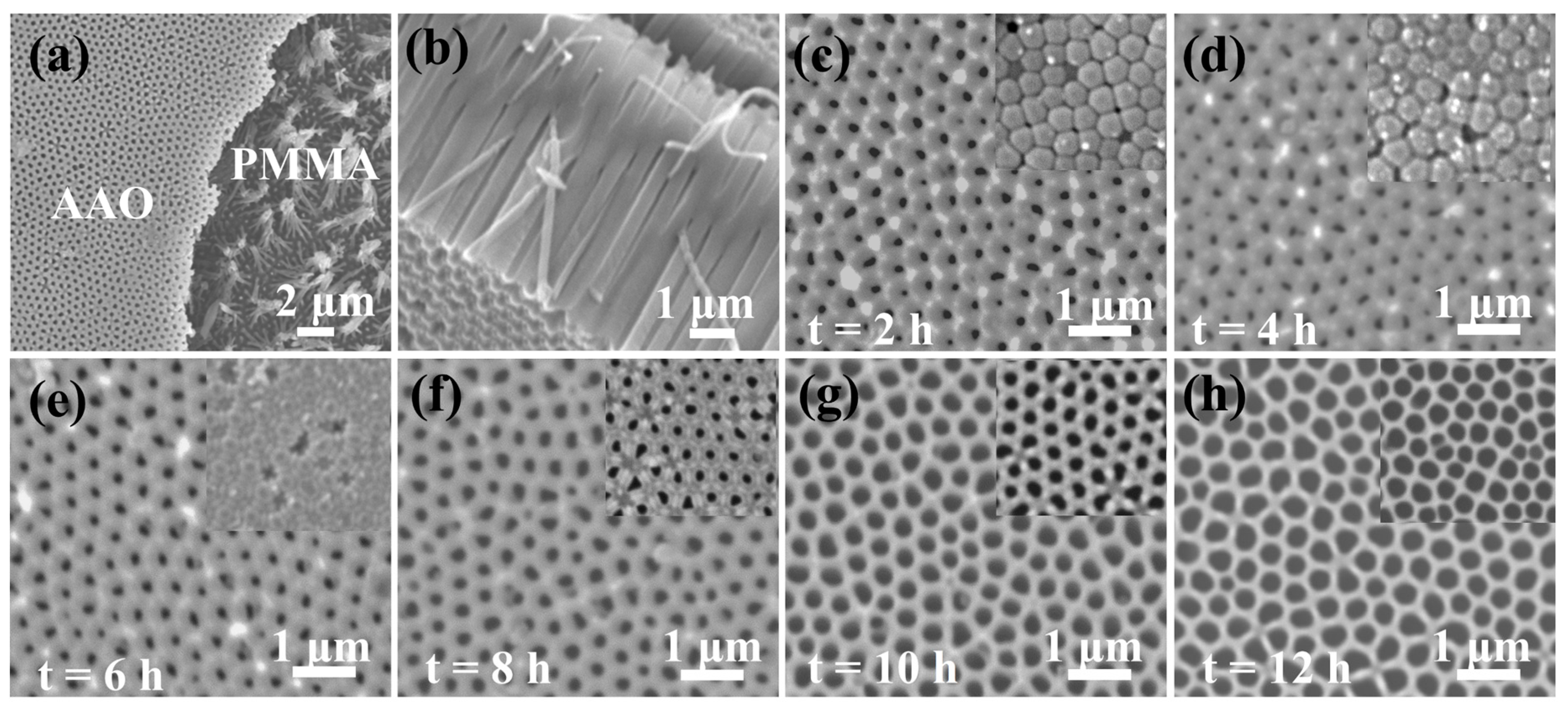
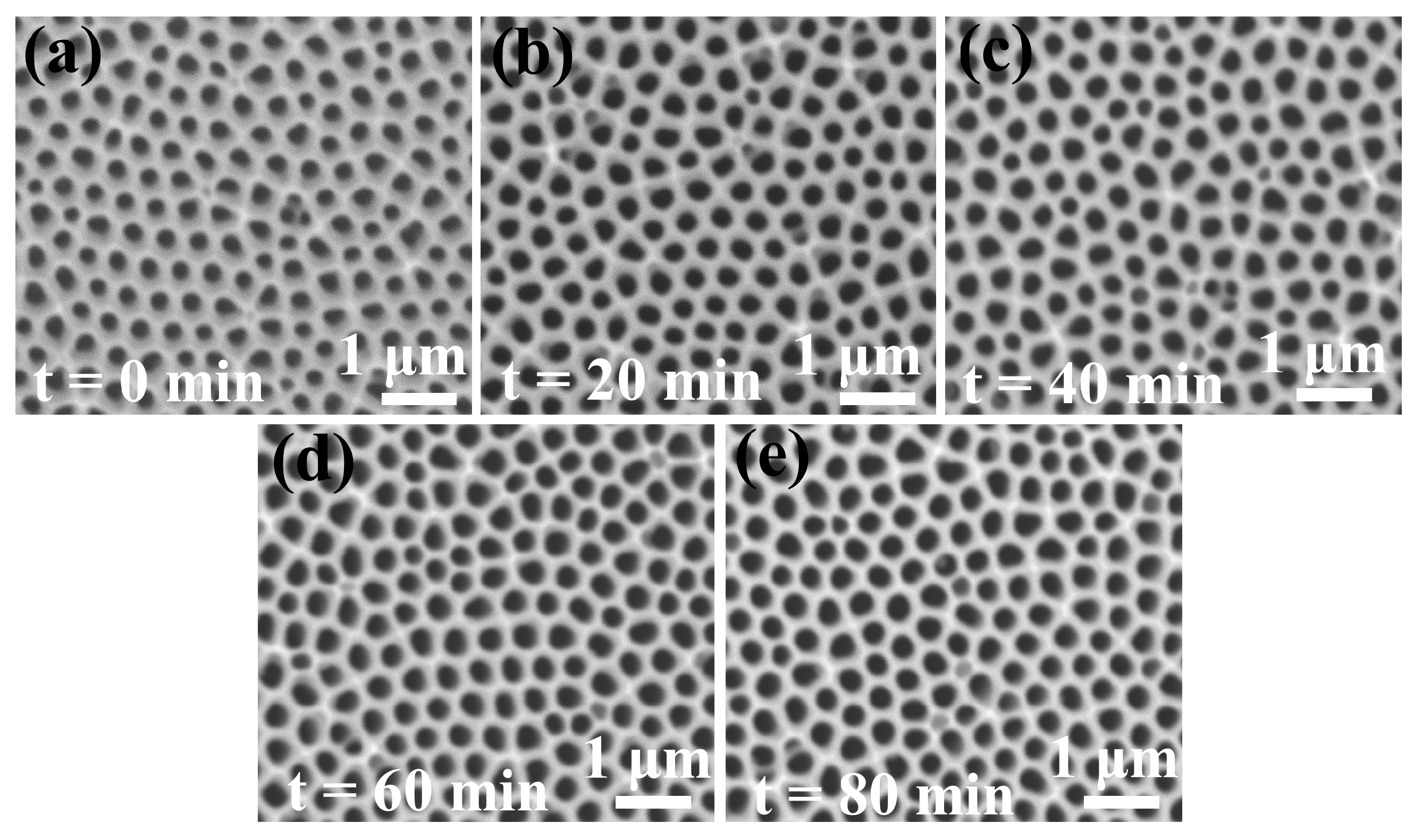
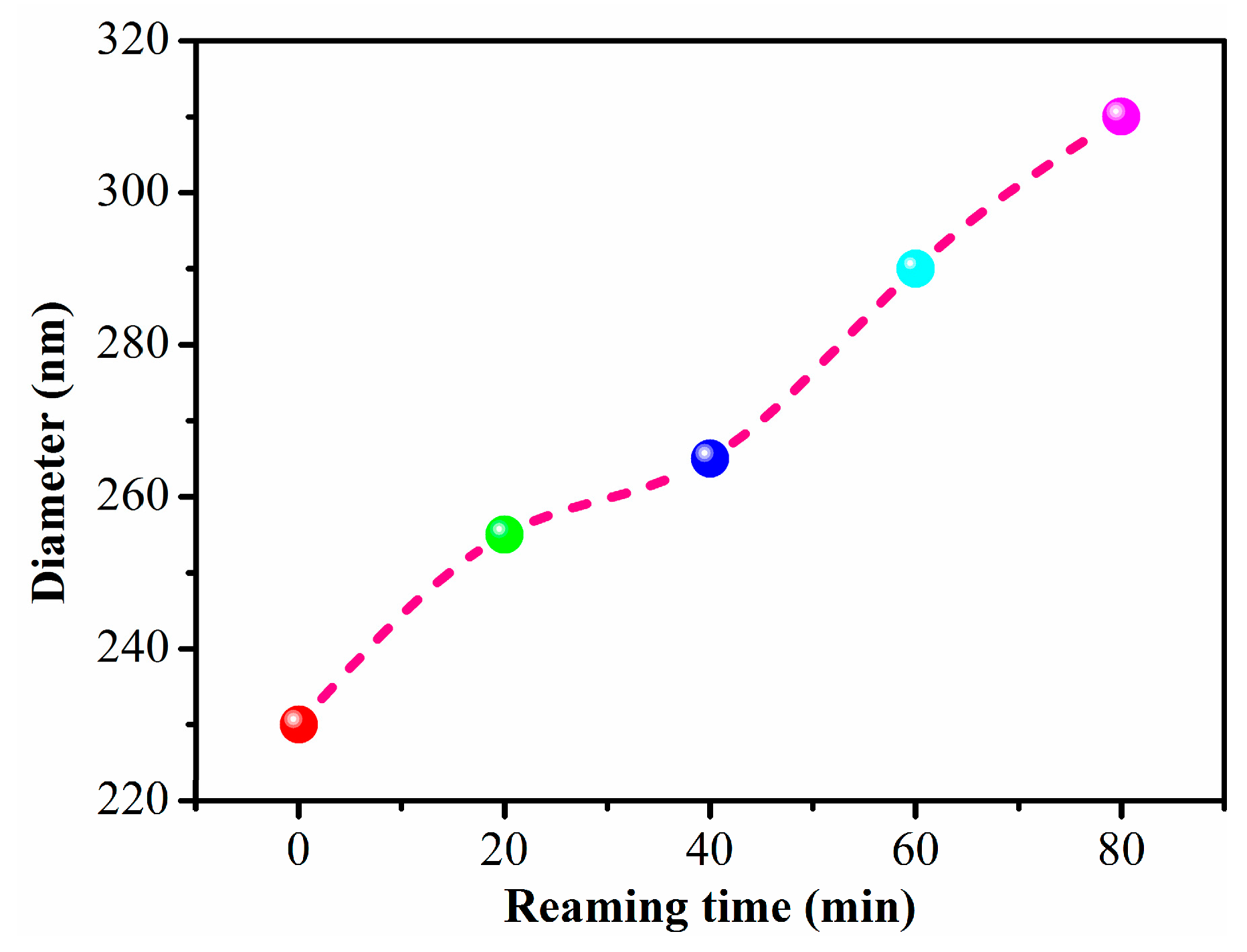
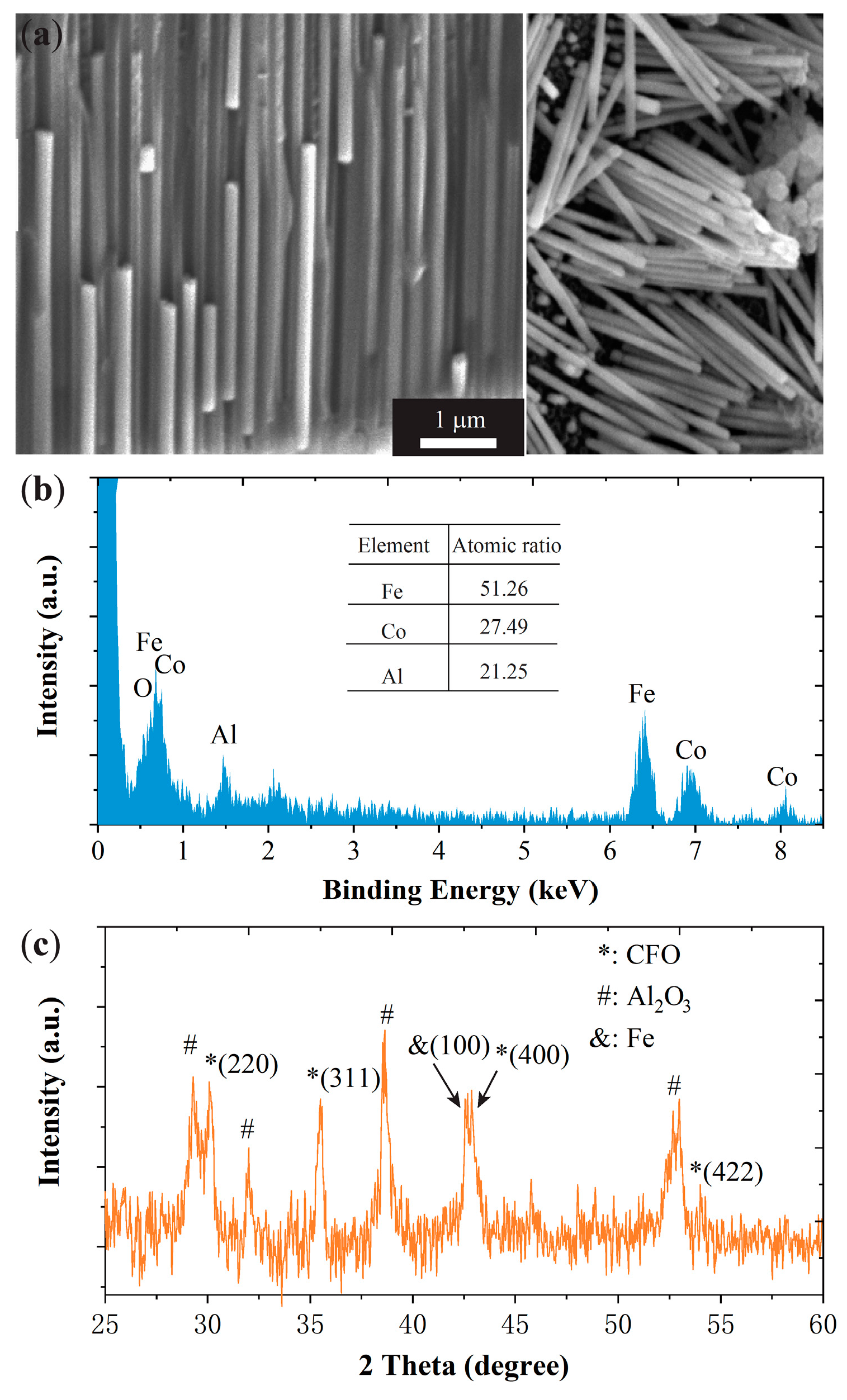
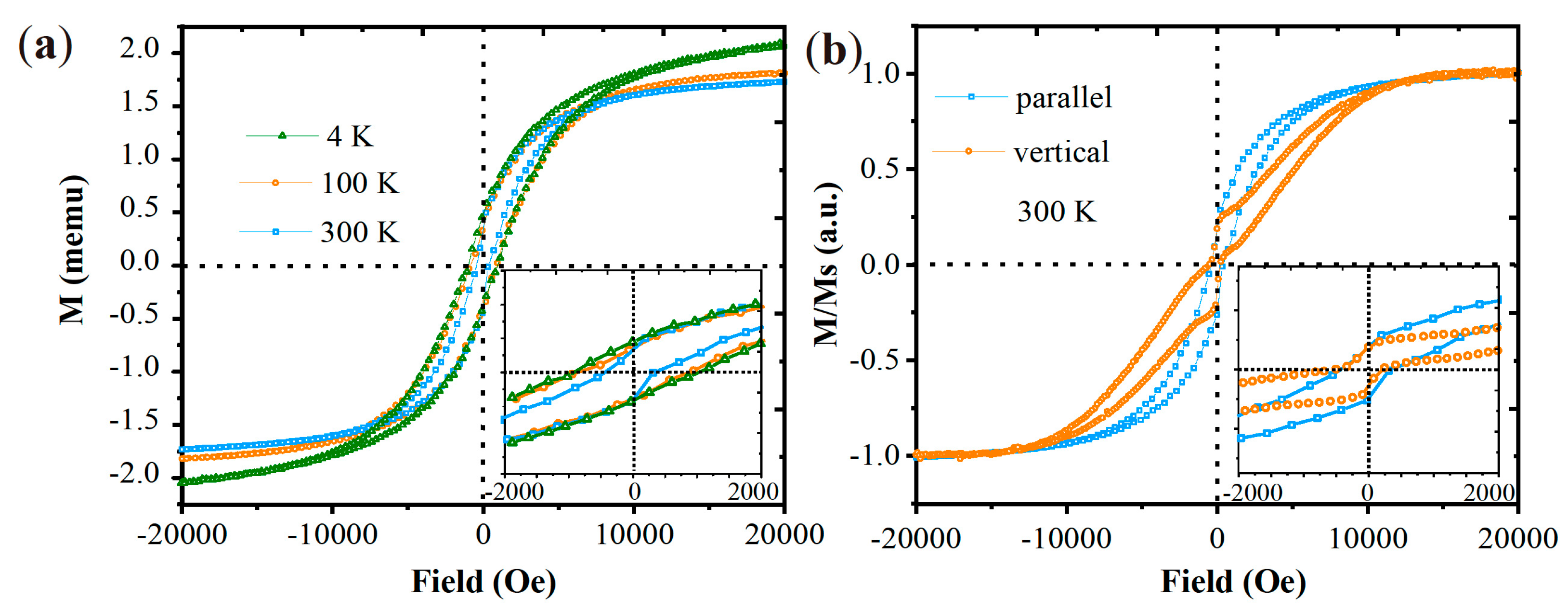
| - | First Anodization | Oxide Removal | Second Anodization |
|---|---|---|---|
| Solution | 0.5 wt % H3PO4 + 0.01 M C2H2O4 | 6 wt % H3PO4 + 1.5 wt % H2CrO4 | 0.5 wt % H3PO4 + 0.01 M C2H2O4 |
| Temperature | 5 °C | 60 °C | 5 °C |
| Time | 2 h | 2 h | - |
© 2020 by the authors. Licensee MDPI, Basel, Switzerland. This article is an open access article distributed under the terms and conditions of the Creative Commons Attribution (CC BY) license (http://creativecommons.org/licenses/by/4.0/).
Share and Cite
Chen, W.; Zheng, H.; Hu, D.; Wu, Q.; Zheng, P.; Zheng, L.; Zhang, Y. Fabrication of CoFe2O4 Nanowire Using a Double-Pass Porous Alumina Template with a Large Range of Pore Diameters. Crystals 2020, 10, 331. https://doi.org/10.3390/cryst10040331
Chen W, Zheng H, Hu D, Wu Q, Zheng P, Zheng L, Zhang Y. Fabrication of CoFe2O4 Nanowire Using a Double-Pass Porous Alumina Template with a Large Range of Pore Diameters. Crystals. 2020; 10(4):331. https://doi.org/10.3390/cryst10040331
Chicago/Turabian StyleChen, Wei, Hui Zheng, Dongping Hu, Qiong Wu, Peng Zheng, Liang Zheng, and Yang Zhang. 2020. "Fabrication of CoFe2O4 Nanowire Using a Double-Pass Porous Alumina Template with a Large Range of Pore Diameters" Crystals 10, no. 4: 331. https://doi.org/10.3390/cryst10040331
APA StyleChen, W., Zheng, H., Hu, D., Wu, Q., Zheng, P., Zheng, L., & Zhang, Y. (2020). Fabrication of CoFe2O4 Nanowire Using a Double-Pass Porous Alumina Template with a Large Range of Pore Diameters. Crystals, 10(4), 331. https://doi.org/10.3390/cryst10040331






